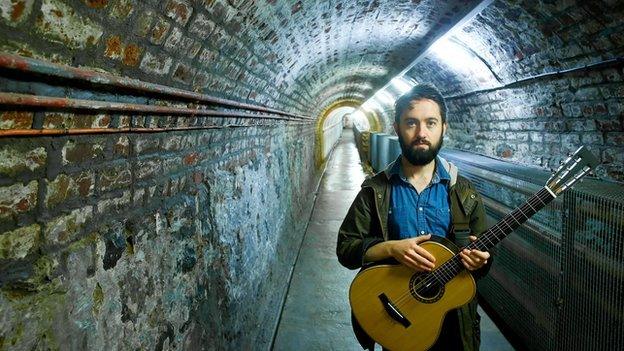Crumlin Road Gaol: Evolution from symbol of conflict to concerts
- Published
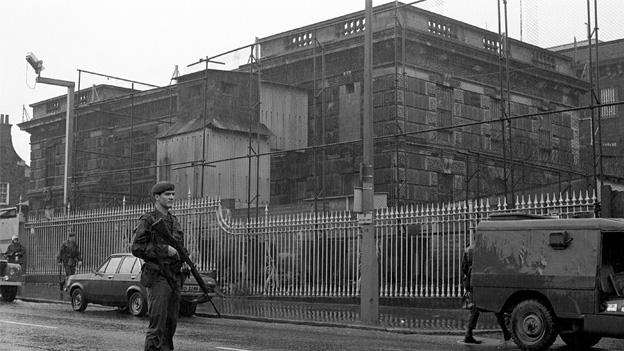
An attempted UDA escape from the Crumlin Road Gaol in 1981 led to the Army checking cars outside
A fortress in the heart of north Belfast, it was once dubbed 'Europe's Alcatraz'.
Having served as an internment camp, borne witness to rebellions and executions and numerous escapes, the Crumlin Road Gaol is a symbol of Ireland's turbulent history.
The final day of March in 2016 marks 20 years since the gaol closed its doors to prisoners and, over the course of 150 years, it has been at the heart of many historic moments.
Marched in chains
Historian Éamon Phoenix describes the building as "grey, black and forbidding".
In the mid-19th century, public executions took place on gallows in the gaol's yard in front of crowds of up to 20,000.
The imposing building still standing proud on the Crumlin Road replaced the old County Gaol in Carrickfergus, County Antrim.
Based on a design by eminent architect and engineer Sir Charles Lanyon, the gaol was built in the Italian renaissance style between 1843 and 1845 and was seen as one of the most advanced prisons of its day.
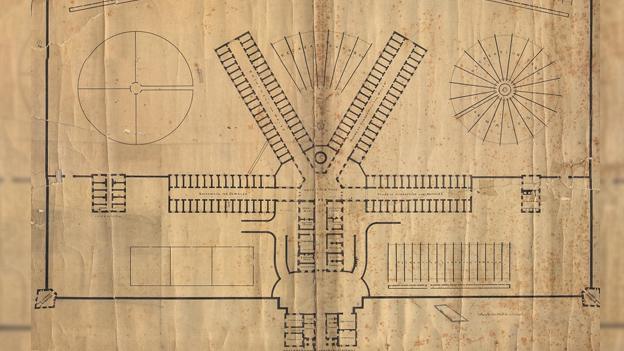
Plans for the new gaol on the Crumlin Road were drawn up by Sir Charles Lanyon
To populate Belfast's newest landmark, 106 inmates were marched the 11 miles from Carrickfergus in chains.
The prisoners included men, women and children, with each group segregated within the new gaol.
Segregation was to become a consistent theme throughout the gaol's history.
Political prisoners
Inside its thick fortified walls the Crum, as it is commonly known, has housed more than 25,000 people including murderers, suffragettes, petty thieves, and republican and loyalist prisoners.
During the Troubles in Northern Ireland, many notable figures were detained there.
Prior to their role as politicians, Ian Paisley and Martin McGuinness both had spells at the Crum, as did loyalist Michael Stone and IRA hunger striker Bobby Sands.
One of the more curious incidents in the the gaol's history led to the then Sinn Féin leader Éamon de Valera being arrested in 1924 for illegally crossing the border in Newry, flouting an order barring him from entering Northern Ireland.
"This imprisonment was the worst prison experience of his life," Dr Phoenix said.

Ian Paisley spent two days in prison for non-payment of fines in protest at the Anglo-Irish Agreement
"He was held in solitary confinement for months and described the food as so bad that he used to feed it to the crows through the bars".
He returned to the cells of north Belfast in 1929.
Again his crime was crossing the border illegally, but he found his second stay a much more pleasurable experience, as Dr Phoenix explains: "De Valera befriended the governor - they had dinner and played chess together.
"And until the end of the governor's days he received a Christmas card from President Éamon de Valera."
Suffragette struggle
During the early 1900s those calling for universal suffrage became increasingly vocal, and groups like the Women's Social and Political Union (WSPU) were becoming ever more radical.
Middle-class women were the core of suffrage movement in Ulster and it was Dorothy Evans who led the WSPU campaign in Ulster.
Evans went so far as to "declare war" on Edward Carson for his lack of progress on the issue, even after he unexpectedly announced that women's suffrage would be granted in 1913.
For Evans and fellow suffragette Madge Muir, this was not enough and they took matters into their own hands.
In 1914, the pair were arrested for possession of explosive substances after a series of arson attacks.
After a police raid on their home uncovered a weapons cache, the women were immediately arrested.
Evans put up so much resistance that she had to be restrained by a number of officers during the court hearing.
This resulted in proceedings being moved to the Crumlin Road Gaol.
The court was in fact moved to a desk in the corridor outside Evans's cell door.
After the magistrate remanded the women in custody, they promptly began a hunger strike which led to their release under the so-called Cat and Mouse Act of 1913, which allowed for the early release of prisoners who were so weakened by hunger striking that they were at risk of death.
Upon their release, the women hired a car, decked it with suffragette flags and defiantly drove around Belfast passing the court where they had caused much outrage.
Unsurprisingly, they were soon returned to the Crum's A-wing, which played host to female prisoners.
Hangman's noose
As Eddie Cullens walked to the gallows, he was still pleading his innocence thousands of miles from home.
A Jewish-American gangster, Cullens was convicted of the murder of Turkish circus worker Achmet Musa in Carrickfergus.
The details would not have been out of place in a gangster movie.
Musa had been shot in the head and his body dumped in a field, naked except for a blue and white swimming cap.
Hanged in 1932, Cullens was one of 17 men executed at Crumlin Road Gaol.
Fifteen of the bodies still remain buried in unconsecrated graves within the prison walls.
The only outward signs of their presence are the initials next to their year of execution, which are scrawled on the walls.
The final execution at the gaol, and indeed Northern Ireland, was that of Robert McGladdery in 1961.
McGladdery was convicted of the murder of Pearl Gamble, strangled and stabbed in a field near her home in Newry, County Down.
"Well, my Lord, there are a lot of things I could say, but I don't think it would make any difference now", said a resigned McGladdery in court as he learned of his fate.
The future
Since the heavy prison gates closed for the final time in 1996, the Crumlin Road Gaol has been transformed.
It is now a grade A listed building and has been redeveloped into a museum, becoming tourist destination.
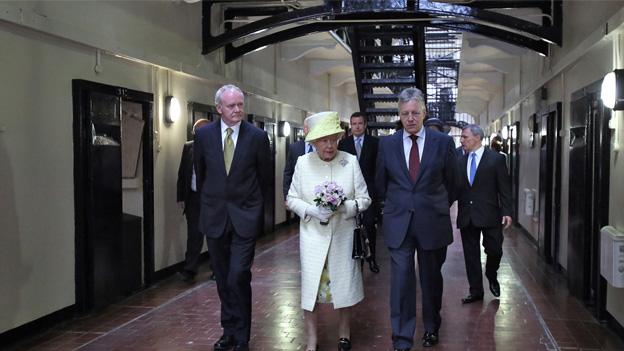
The Queen was shown around the gaol by Martin McGuinness and Peter Robinson in 2014
The gaol welcomed Queen Elizabeth II in 2014.
On her visit she was flanked by Northern Ireland's then First Minister Peter Robinson and Deputy First Minister Martin McGuinness.
Both were former inmates of the Crumlin Road Gaol.
As Dr Phoenix said: "It has now made the radical transformation from symbol of the Troubles to heritage site."
But although it now plays host to public tours, movie screenings and music concerts, it is said that the walls still echo and howl of a time that the Crum was a bastion of pain and suffering.
- Published18 June 2014
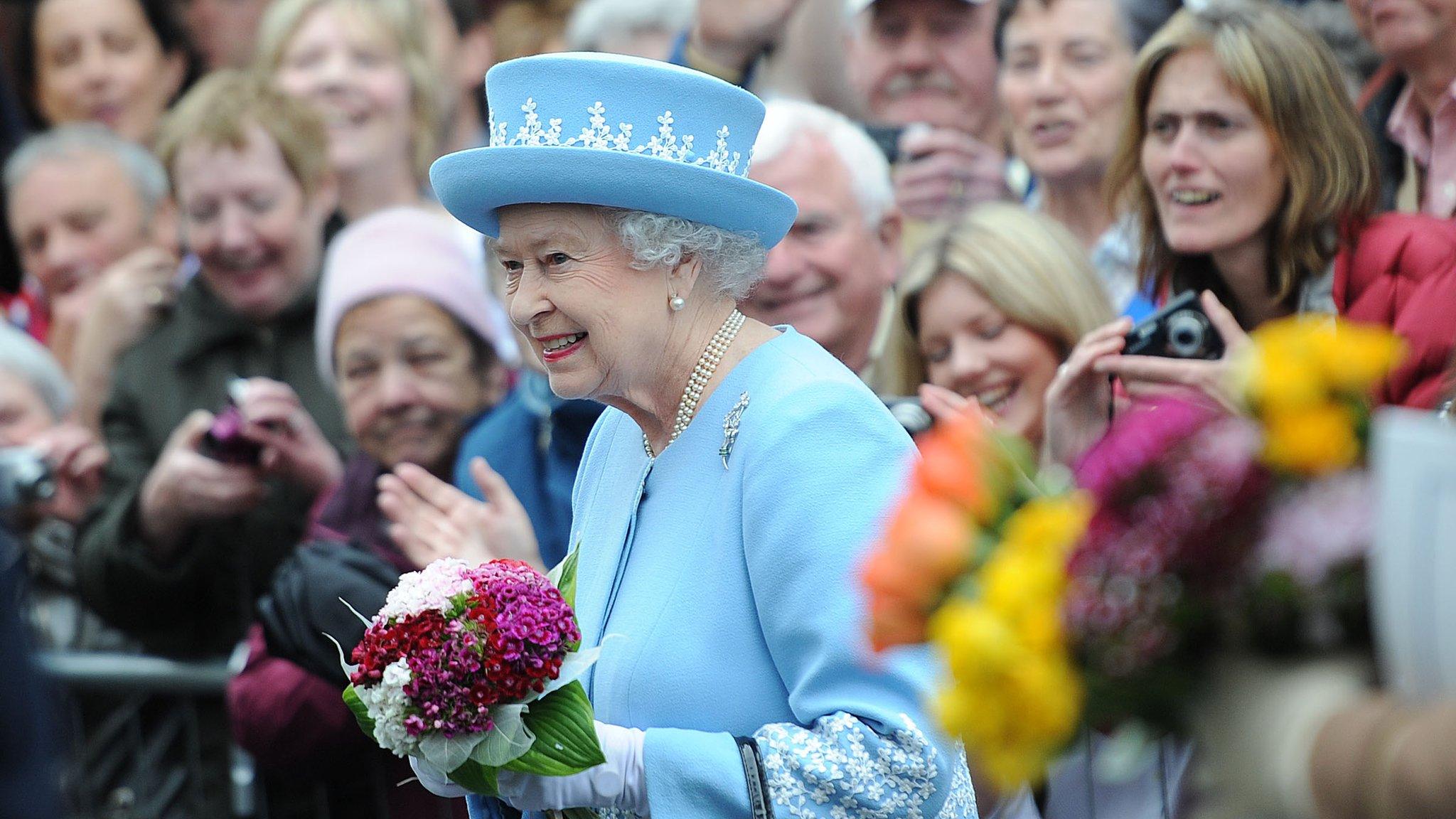
- Published27 June 2012
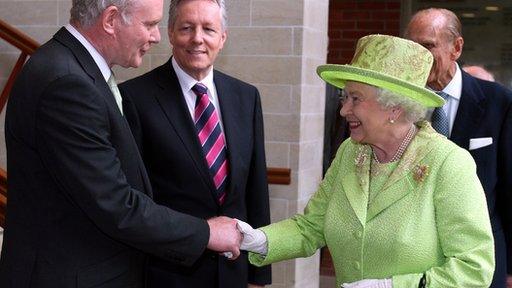
- Published2 June 2015
